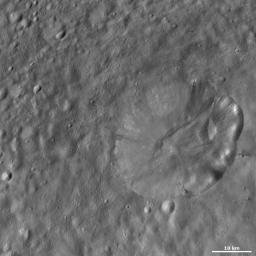Octavia Crater
Caption:
This Dawn framing camera (FC) image of Vesta shows Octavia crater, which is the large crater in the right of the image. Octavia crater dominates the landscape of Vesta that is visible in this image: it is approximately 30 kilometers (19 miles) in diameter and the next largest crater is only approximately 4 kilometers (2 miles) in diameter. Octavia's rim is fresher on the right side and more degraded on the left side. The left side may be more degraded due to slumping of material into the center of the crater. There is a linear build-up of material in the center of the crater, which probably accumulated from slumping. The fresher part of the rim has a scalloped edge and there is no obvious cause visible in the image for this particular morphology. There are patches of dark and bright material throughout the crater, most noticeably below the rim on the right side.
Background Info:
The Dawn mission to Vesta and Ceres is managed by NASA's Jet Propulsion Laboratory, a division of the California Institute of Technology in Pasadena, for NASA's Science Mission Directorate, Washington D.C. UCLA is responsible for overall Dawn mission science. The Dawn framing cameras have been developed and built under the leadership of the Max Planck Institute for Solar System Research, Katlenburg-Lindau, Germany, with significant contributions by DLR German Aerospace Center, Institute of Planetary Research, Berlin, and in coordination with the Institute of Computer and Communication Network Engineering, Braunschweig. The Framing Camera project is funded by the Max Planck Society, DLR, and NASA/JPL.
More information about the Dawn mission is online at
http://www.nasa.gov/dawn
and
http://dawn.jpl.nasa.gov
.
Cataloging Keywords:
| Name |
Value |
Additional Values |
| Target |
4 Vesta |
|
| System |
Main Belt |
|
| Target Type |
Asteroid |
|
| Mission |
Dawn |
|
| Instrument Host |
Dawn |
|
| Host Type |
Orbiter |
|
| Instrument |
Framing Camera (FC) |
|
| Detector |
|
|
| Extra Keywords |
Crater, Grayscale |
| Acquisition Date |
|
| Release Date |
2012-05-11 |
| Date in Caption |
|
|
| Image Credit |
NASA/JPL-Caltech/UCLA/MPS/DLR/IDA |
| Source |
photojournal.jpl.nasa.gov/catalog/PIA15649 |
| Identifier |
PIA15649 |

 Planetary Data System
Planetary Data System
